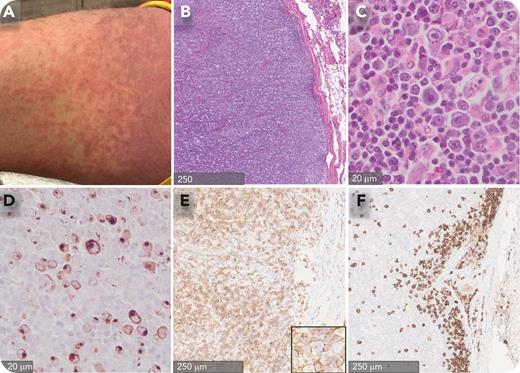A 20-year-old man presented with progressive fevers, neck swelling, and a diffuse, pruritic rash (panel A), suggestive of drug reaction with eosinophilia and systemic symptoms (DRESS) syndrome after being on minocycline for acne. Clinical laboratory tests showed leukocytosis and eosinophilia, liver dysfunction indicated by elevated transaminases and lactate dehydrogenase, and a computed tomographic scan highlighting lymphadenopathy and hepatosplenomegaly. A lymph node biopsy displayed disrupted architecture with marked paracortical expansion (panel B, original magnification ×1.2). Dominating the paracortex were large mononuclear cells with noticeable nuclear and cytoplasmic inclusions (panel C, original magnification ×40). Immunohistochemical stains confirmed infection by human herpesvirus 6 (HHV-6) (panel D, original magnification ×40; HHV-6 antibody C65020M, clone 200, target gp60/100; Meridian Life Science) with membrane and Golgi positivity. Infected cells and background lymphocytes were positive for inducible T-cell costimulator (ICOS) (panel E, original magnification ×10, inset: ICOS-positive T-helper cell with nuclear inclusion). Reactive B cells were largely confined to the far cortex (panel F, original magnification ×10). Polymerase chain reaction studies were negative for T-cell receptor γ–gene rearrangement.
This histologic picture can mimic lymphoma, which was the initial suspected diagnosis. HHV-6 reactivation can occur in DRESS cases, leading to marked systemic symptoms and generalized lymphadenopathy. This case underscores the importance of a holistic evaluation, combining both clinical and histological data, to avoid misdiagnosis and provide appropriate treatment. In this case, treatment with high-dose prednisone led to symptom improvement over 1 month.
For additional images, visit the ASH Image Bank, a reference and teaching tool that is continually updated with new atlas and case study images. For more information, visit https://imagebank.hematology.org.


This feature is available to Subscribers Only
Sign In or Create an Account Close Modal